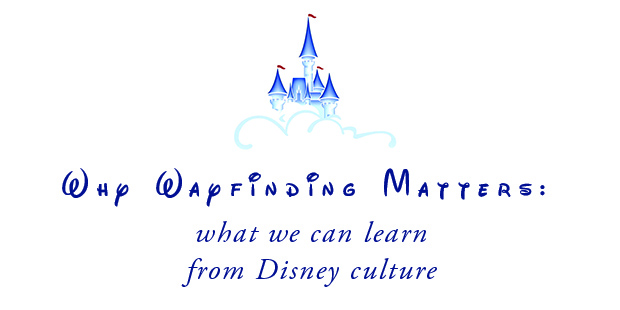
The Wayfinding Design Process
The job of the wayfinding designer is to present information in public spaces that helps facilitate a seamless guest experience.
– David Gibson, The Wayfinding Handbook
When people attempt to navigate a place for the first time, they face a series of decisions as they follow a path to their destination. There is a sequential pattern to this wayfinding process – in effect, a series of questions that people ask themselves along the way. Before starting the design process, the wayfinding designer must anticipate guest patterns, understand that logic, and apply it in the planning phase. Then work can begin on a framework for the wayfinding design program.
Here’s a scenario that’s probably familiar to many of you:
Imagine you are driving your family of five into Walt Disney World for the first time. As you approach the main entrance, you look up to see the sign. Most likely, you have excited children talking, laughing, or maybe singing “Let It Go.” In addition, you are listening to both your wife and your GPS instructions, trying to decide which one to follow.
Just after you drive through this sign, you immediately begin to see other signs – lots of signs!
Once you are in Walt Disney World proper, you have to locate your Resort, or maybe you are going to one of the Parks first. You approach one, feeling a mixture of hesitance and excitement: Am I going in the right direction? Is the resort I want to go to? Once in the parking lot, if there is no clear entrance marked, are you going in the right door? And once inside, How do you find the registration desk you are looking for?
At each stage in this sequence, the Guest must make decisions based on the available, and readily visible, information. The job of the wayfinding designer is to present information in public spaces that helps facilitate a seamless guest experience. In other words, the necessary sequence of movement should feel as effortless and simplified as possible so that ten steps seem to require only two or three.
The designer’s challenge is to determine where to locate signs, what they should say, and how they should say it. Thoughtful research and analysis help the designer understand a complex public place, such as a hospital or a campus or a subway system. In the process of tracing the guest’s path, the designer attempt to uncover the hidden logic of the place. Once that is clear, the designer can develop a strategic framework for the wayfinding system.
NEWS FLASH: All of the above statements are also true in churches.
When Guests come to your facilities, do they know how to drive into the parking lots? Do they know which building they are going to? Do they know which door to enter? Can they easily determine where they need to go once they step inside the building?
Church leaders must think like wayfinding designers in order to help Guests and members have a seamless guest experience while on your campus. Nothing less than excellence should be the goal.
Part Three: Sign Language
Part One: Why Wayfinding Matters: What We Can Learn from Disney Culture
Information for this series of posts comes primarily from The Wayfinding Handbook by David Gibson. It is an excellent resource for leaders who want to apply the art and science of wayfinding to their organizations.

Tags: Disney culture, Wayfinding














